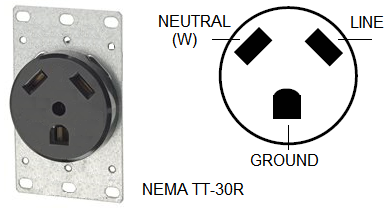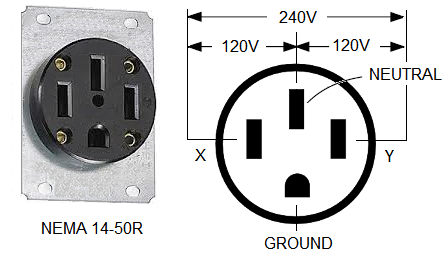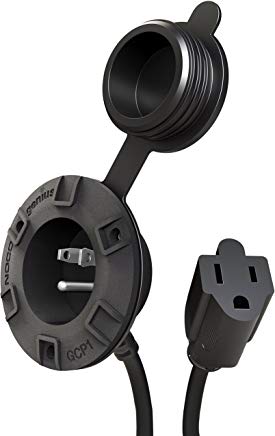Table of Contents
Words of Wisdom: “…most people think that to have “RV” type shore power you need those special 30/50 amp plugs. I have a 115v plug. The male end of an extension cord (heavy gauge) that I have cable tied to the inside of my receiver hitch so it’s hidden.” – Captain_Dapper1)
Shore power
Shore power (“grid power”, “mains”, “wall outlet power”) is AC power derived from the electric grid. Shore power can run AC loads directly in campers so equipped and/or power a converter/charger that runs the 12v house system and charges the battery bank.
The most common places RVers use shore power is when plugged in at someone's house or at an RV park with full hookups (FHU).
United States
The US power grid is 120VAC at 60Hz.
 The most common types of campsite hookups are:
The most common types of campsite hookups are:
- 15A/20A and 30A
- 30A and 50A, with 50A costing more
- 15A/20A only
- 30A only
15A/20A shore power
15A power receptacles are the familiar ones found in a residence.2) They can carry 1800W3) and are the type of shore power many DIY RVs and vans are built around.4).
20A power receptacles are rated for 2400W5). They look like 15A outlets but the “hot” leg has an additional spur.6) This arrangement allows 15A plugs to go into 20A receptacles but prevents the heavier duty 20A plugs from being used in a less-powerful 15A circuit.7) Because of the backward-compatible 20A socket folks with 15A rigs can safely plug in at both 15A and 20A hookups.
Note: If “driveway surfing” on an extension cord, using a 10A circuit breaker on the RVs AC breaker box will prevent tripping a residential circuit breaker when the RVer might not have access to reset it. A 15A breaker might or might not, depending on whether the RV or residential breaker trips first.
A 'dweller can safely power a 15A RV from a 30A outlet with an adapter. 15A Extension cords should be 12-14ga for 50' cords and 10-12ga for 100' cords.
Mike Sokol of RV electrical fame, says:
if there’s a 20-amp circuit breaker and 12-gauge wire feeding a 15-amp outlet, it’s actually rated for 20-amps of current. There’s an exception in the code as well as UL allowing this, so don’t worry. If you’re on a 20-amp breaker with 12-gauge wiring, then you have a 20-amp circuit, even if it’s using a NEMA 5-15 outlet.8)
30A shore power
 30A is the standard setup for small-to-medium RVs.9) It can supply 3600W,10) typically sufficient to run an air conditioner and other items in the RV. The NEMA TT-30R plug is common. There is also a L5-30R twist-lock style.
30A is the standard setup for small-to-medium RVs.9) It can supply 3600W,10) typically sufficient to run an air conditioner and other items in the RV. The NEMA TT-30R plug is common. There is also a L5-30R twist-lock style.
If the 30A circuit on a 30A/50A pedestal is broken or malfunctioning the camper can use an adapter to get power from the 50A circuit.11) Note this may incur a price increase from the park.
The 30A-equipped RV can also run off a 15A/20A outlet with an adapter but would have to be careful not to exceed the 15A/20A limit.
50A shore power
 50A systems are most common in large, luxury RVs with two or more A/C units.12) The 50A RV power pedestal has two 50A 120V legs13) (split-phase) and can deliver 6,000W of power on each leg.14)
50A systems are most common in large, luxury RVs with two or more A/C units.12) The 50A RV power pedestal has two 50A 120V legs13) (split-phase) and can deliver 6,000W of power on each leg.14)
50A to 30A adapters will use one leg of the outlet to feed the RV with 50A.
constant-duty rating
The constant-duty15) rating of each is 0.8 of the normal rating:
- 50A is rated to 6,000w on each leg (4,800w constant duty)
- 30A is rated to 3,600w (2,880w constant duty)
- 20A is rated to 2,400w (1,920w constant duty)
- 15A is rated to 1,800w (1,440w constant duty)
ports
 A shore power port is designed to let you plug power cables into the side of your van or RV.
A shore power port is designed to let you plug power cables into the side of your van or RV.
Vans typically use 15A ports. Smaller RVs and some vans use 30A service – they use this kind of port.
Some are pre-cabled so you can plug the inside cable to a power strip, breaker box, or other distribution device. A converter/charger can then be wired to the distribution point.
- use a hole saw to bore the hole in the van wall to the port's specification
- sand the edges to remove sharp edges
- treat edges with paint, primer, rust preventive, etc to prevent rust. The edges will not be visible once the port is installed
adapters
There are adapters you can use to adapt RV pedestal outlets so you can plug them into your shore power port. Examples:
power testers
A power tester can check for the presence of power, “good ground, open circuits, reversed polarity and safe voltage.”16)
The one shown here is for 120vac outlets but others are available for 30A outlets and for 50A outlets.
surge protectors
Dogbone surge protectors are inexpensive, but they are generally only good for one surge (or maybe several small ones). More full-featured surge protectors will disconnect power to the RV in over/undervolt conditions and will reconnect after a certain period of stability.
transfer switches
A transfer switch allows you to run AC loads off the inverter, but switch to shore or generator power instead when that source is available.
- inverter output → transfer switch AC source 1 (default)
- shore power → transfer switch AC source 2 (use grid power when you have it)
and
- transfer switch output → AC loads
Since RVs spend more time on pedestal power than campervans such devices are more common on RVs.
The switches can be manual or automatic. On the latter, the switchover time is measured in milliseconds.
Europe
The grid standard on the European continent is 230Vac at 50Hz.
RV outlets are reported to be mainly type C, 16A (3,680w).17)
United Kingdom
The grid standard on the European continent is 230Vac at 50Hz.
RVs connect with type G, 13A (2,990w). 



